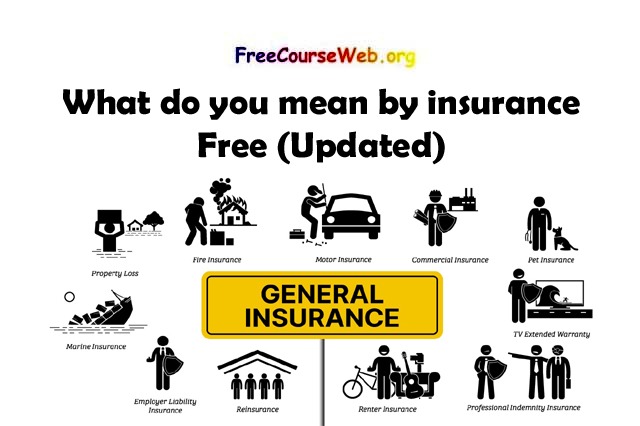What do you mean by insurance Insurance is a contract between an individual or entity and an insurance company

Where the individual or entity pays a premium in exchange for the insurance company’s protection against certain risks.
The insurance company promises to pay a designated beneficiary a sum of money (the “insurance benefit”) upon the occurrence of a specified event (such as death, injury, or property damage). The purpose of insurance is to provide financial protection and peace of mind to the insured individual or entity, by transferring the risk of loss to the insurance company.
There are many different types of insurance, including life insurance, health insurance, car insurance, home insurance, and liability insurance. Each type of insurance is designed to protect against specific types of risks, and the terms and conditions of each insurance policy will vary depending on the type of insurance and the needs of the insured.
1. What is insurance and its types?
Insurance is a financial product that provides protection against loss or damage. It is a contract between the insured and the insurance company, where the insured pays a premium in exchange for the insurance company’s promise to pay a specified amount of money in the event of a covered loss. The purpose of insurance is to provide financial security and peace of mind by transferring the risk of loss from the insured to the insurance company.
There are several types of insurance, including:
- Life insurance: This type of insurance provides a death benefit to the beneficiary of the policy in the event of the death of the insured.
- Health insurance: This type of insurance covers the cost of medical expenses, including hospitalization, surgery, and prescription drugs.
- Property and casualty insurance: This type of insurance covers losses to property, such as homes, cars, and businesses, as well as liability coverage for lawsuits.
- Auto insurance: This type of insurance provides coverage for damage to your car and liability coverage in case you cause an accident.
- Home insurance: This type of insurance provides coverage for damage to your home and its contents, as well as liability coverage in case someone is injured on your property.
- Liability insurance: This type of insurance provides coverage for damages or injuries that you may cause to others, such as medical expenses or legal fees.
- Disability insurance: This type of insurance provides income replacement in the event that the insured becomes unable to work due to injury or illness.
- Long-term care insurance: This type of insurance covers the cost of long-term care services, such as nursing home care or in-home care.
These are just a few examples of the types of insurance that are available. The type of insurance that is right for you will depend on your individual needs and circumstances.
Top 10 Health Insurance Companies
2. What is the main purpose of insurance?
The main purpose of insurance is to provide financial protection against loss or damage. Insurance transfers the risk of loss from the insured individual or entity to the insurance company. By paying a premium, the insured is protected against the financial consequences of covered events, such as death, injury, property damage, or liability.
The primary goal of insurance is to provide peace of mind and financial security. For example, if you have health insurance, you are protected against the high cost of medical care in the event of an injury or illness. If you have auto insurance, you are protected against the cost of repairs or replacement of your car in the event of an accident. And if you have life insurance, you can provide financial security for your loved ones in the event of your death.
Insurance helps to manage the financial impact of unexpected events and provides a safety net in the case of loss or damage. This helps individuals and businesses to manage the financial risks associated with their assets and activities, and to plan for the future with more confidence and security.
3. What is insurance and its benefits?
Insurance is a financial product that provides protection against loss or damage. It is a contract between the insured and the insurance company, where the insured pays a premium in exchange for the insurance company’s promise to pay a specified amount of money in the event of a covered loss.
The benefits of insurance can be broadly categorized as financial protection and peace of mind. Some of the specific benefits of insurance include:
- Financial protection: Insurance provides financial protection against the cost of covered losses, such as medical expenses, property damage, and liability. This helps to manage the financial impact of unexpected events and provides a safety net in the case of loss or damage.
- Peace of mind: Insurance provides peace of mind by transferring the risk of loss from the insured to the insurance company. The insured can have confidence knowing that they are protected against the financial consequences of covered events.
- Risk management: Insurance helps individuals and businesses to manage the financial risks associated with their assets and activities. This allows them to plan for the future with more confidence and security.
- Access to resources: Insurance can provide access to resources, such as medical care, that may not be affordable without insurance coverage.
- Tax benefits: In some cases, the premiums paid for insurance may be tax deductible, which can provide additional financial benefits.
Overall, insurance provides financial protection and peace of mind to individuals and businesses, allowing them to manage the financial risks associated with their assets and activities. The specific benefits of insurance will vary depending on the type of insurance and the needs of the insured.
4. What are the 3 main types of insurance?
There are many different types of insurance, but the three main categories are:
- Life insurance: This type of insurance provides a death benefit to the beneficiary of the policy in the event of the death of the insured. There are several types of life insurance, including term life insurance, whole life insurance, and universal life insurance.
- Property and casualty insurance: This type of insurance covers losses to property, such as homes, cars, and businesses, as well as liability coverage for lawsuits. Examples of property and casualty insurance include homeowners insurance, auto insurance, and liability insurance.
- Health insurance: This type of insurance covers the cost of medical expenses, including hospitalization, surgery, and prescription drugs. There are several types of health insurance, including individual health insurance, group health insurance, and Medicare.
These three categories represent the broadest types of insurance, and within each category there are many specific types of insurance that are designed to meet the specific needs of individuals and businesses. The type of insurance that is right for you will depend on your individual needs and circumstances.
5. What are the 7 principles of insurance?
The 7 principles of insurance are widely recognized as the fundamental concepts that underlie the practice of insurance. These principles are:
- Utmost good faith: This principle requires that both the insurer and the insured act in good faith and disclose all material information relevant to the insurance contract.
- Insurable interest: The insured must have an insurable interest in the property or life being insured. This means that the insured must have a financial stake in the property or life being insured.
- Proximate cause: The cause of the loss must be the proximate cause of the loss, meaning that the cause of the loss must be the direct and immediate cause of the loss, rather than a remote or indirect cause.
- Indemnity: The purpose of insurance is to indemnify the insured, meaning that the insurance company will pay the insured the amount of the covered loss, but not more than the insured’s actual loss.
- Subrogation: This principle allows the insurance company to take over the rights of the insured to recover damages from a third party responsible for the loss.
- Contribution: In the event that multiple insurance policies cover the same loss, this principle requires that the insurance companies contribute to the payment of the loss in proportion to the amount of coverage provided by each policy.
- Causa proxima non remota spectator: This Latin phrase means that the nearest cause, not the remote cause, is the one that determines the liability of the insurer.
These 7 principles are widely recognized as the cornerstone of insurance and are used to guide the practice of insurance and the interpretation of insurance policies. Understanding these principles is essential for anyone involved in the insurance industry, including insurance agents, brokers, and underwriters, as well as individuals who are purchasing insurance coverage.
6. What is risk in insurance?
Risk in insurance refers to the possibility of loss or damage to an individual or business. Insurance is designed to provide financial protection against risks, and the concept of risk is at the core of the insurance industry.
In insurance, risk is the chance that an insured event will occur and cause a loss to the individual or business. Some examples of risks include:
- Health risks: The risk of becoming sick or injured and incurring medical expenses.
- Property risks: The risk of damage or loss to property, such as homes, cars, and businesses.
- Liability risks: The risk of being sued and held legally responsible for injury to another person or damage to their property.
- Financial risks: The risk of financial loss, such as the loss of income or savings due to unemployment, disability, or death.
Insurance companies assess and manage risk by determining the likelihood of a loss occurring and setting the premium for the insurance policy accordingly. The goal of insurance is to spread the risk of loss among a large pool of policyholders, so that the financial impact of losses is manageable for the insurance company and the policyholders.
Risk is an inherent part of life, and insurance provides a way to manage and mitigate the financial consequences of risks. By purchasing insurance, individuals and businesses can transfer some of the financial risks they face to the insurance company, and have peace of mind knowing that they are protected against the financial impact of unexpected events.
7. What are 5 advantages of insurance?
There are several advantages to having insurance, including:
- Financial protection: Insurance provides financial protection against the cost of unexpected events, such as medical expenses, property damage, and liability claims. This protection helps individuals and businesses manage the financial impact of these events and reduce financial stress.
- Peace of mind: Having insurance can provide peace of mind and security, knowing that you are protected against unexpected events and their financial consequences.
- Manages risk: Insurance helps manage and mitigate risk by spreading the risk of loss among a large pool of policyholders. This helps make the financial impact of losses manageable for both the insurance company and the policyholders.
- Compliance: Certain types of insurance are required by law, such as car insurance, and having insurance can help individuals and businesses comply with legal requirements and avoid penalties.
- Estate planning: Life insurance can be an important part of estate planning and can provide financial protection for loved ones in the event of the death of the insured. Life insurance can also be used as a tax-efficient way to transfer wealth to future generations.
In addition to these advantages, insurance can also offer additional benefits, such as access to specialized resources, like claims adjusters, and legal and medical assistance, as well as the ability to customize coverage to meet individual needs and circumstances.
8. Is insurance an asset?
Whether insurance is considered an asset depends on the type of insurance and the context in which it is being evaluated.
From a financial perspective, insurance can be considered an asset if it provides a future financial benefit. For example, life insurance can be considered an asset if it provides a death benefit that can be used to pay for expenses such as funeral costs, mortgage payments, or other debts. Similarly, a health insurance policy can be considered an asset if it provides financial protection against the cost of medical expenses.
However, insurance can also be considered a liability in some cases. For example, an insurance policy that requires the payment of ongoing premiums can be considered a liability because it requires a future outlay of funds.
Ultimately, whether insurance is considered an asset or a liability depends on the specific circumstances and the purpose for which it is being evaluated. It is important to understand the nature of the insurance policy and its potential benefits and obligations before making any decisions about its classification as an asset or liability.
9. What is claims in insurance?
A claim in insurance refers to a request for payment made by a policyholder under the terms of an insurance policy. The purpose of a claim is to receive compensation for a loss or damage that is covered under the terms of the policy.
For example, if an individual has a car insurance policy and is involved in a car accident, they can make a claim under their policy to receive compensation for the damages to their vehicle. Similarly, if an individual has a health insurance policy and incurs medical expenses due to an illness or injury, they can make a claim under their policy to receive compensation for these expenses.
The process of making a claim typically involves the policyholder providing proof of the loss or damage to the insurance company, such as a police report for a car accident or medical bills for a health claim. The insurance company will then evaluate the claim and determine if it is covered under the policy, and if so, the amount of compensation that will be paid.
The goal of insurance is to provide financial protection against losses and damages, and the process of making a claim is an important aspect of the insurance experience. By making a claim, policyholders can receive the financial assistance they need to recover from unexpected events and manage the financial impact of these events.
10. What is a disadvantage of insurance?
While insurance can provide many benefits, there are also several disadvantages to consider, including:
- Cost: Insurance can be expensive, especially for policies that provide comprehensive coverage. Premiums for insurance policies can add up over time and can be a significant expense for individuals and businesses.
- Deductibles: Many insurance policies have deductibles, which are the amounts that policyholders must pay out of pocket before the insurance coverage takes effect. This means that policyholders may still be responsible for paying a significant portion of the costs for covered losses, even with insurance.
- Limitations: Insurance policies have limits and exclusions, which means that there are certain types of losses or damages that may not be covered. Policyholders may be surprised to learn that their insurance coverage is not as comprehensive as they thought, which can lead to financial losses in the event of a covered loss.
- Complexity: Insurance policies can be complex and difficult to understand, making it difficult for policyholders to fully understand their coverage and the protection they have. This can also make it difficult to compare different insurance options and choose the best coverage for their needs.
- Claim denials: Insurance companies may deny claims for a variety of reasons, such as a policyholder failing to meet policy requirements or the loss or damage being excluded from coverage. This can be frustrating for policyholders who have paid their premiums and expect to receive coverage for their losses.
- Processing time: The process of making a claim can be time-consuming and involve extensive paperwork and documentation. Policyholders may also experience delays in receiving payment for their claims, which can be a significant financial hardship.
In conclusion, insurance can be a valuable tool for managing risk, but it is important to understand the potential disadvantages and to carefully evaluate the costs and benefits of different insurance options.




